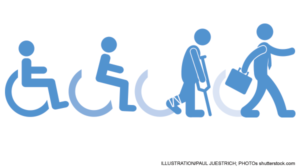Disability Insurance: A Safety Net for Unexpected Life Events
Disability insurance is a type of insurance coverage designed to provide financial protection in the event that an individual becomes disabled and is unable to work.1 It offers a source of income replacement to help cover essential expenses when a person is unable to earn their regular income due to a disabling illness or injury.

How Disability Insurance Works
Disability insurance policies typically provide a percentage of the individual’s pre-disability income, usually ranging from 50% to 70%, allowing them to maintain a certain level of financial stability during their disability.45 The policy may also include additional benefits, such as:
- Cost of Living Adjustments (COLA): To help offset the effects of inflation on your income.6
- Residual Disability Benefits: To provide partial benefits if you can still work but at a reduced capacity.7
- Waiver of Premium: To waive future premiums if you become disabled.8
Types of Disability Insurance
- Short-Term Disability Insurance: Provides coverage for temporary disabilities, typically lasting a few weeks or months.9 It’s often available through employers or purchased independently.10
- Long-Term Disability Insurance: Provides coverage forlonger-term disabilities, typically lasting for years or even until retirement.11 It’s crucial for individuals whose income is essential for their family’s financial well-being.
- Social Security Disability Insurance (SSDI): A government-funded program that provides benefits to individuals who cannot work due to a medically-determinable physical or mental impairment.12
Why Disability Insurance is Important
- Unexpected Events: Disabling events can occur unexpectedly, such as accidents, illnesses, or injuries.
- Financial Hardship: Loss of income due to disability can have a significant financial impact on individuals and families, leading to debt, difficulty paying bills, and even losing their homes.13
- Peace of Mind: Disability insurance provides a safety net, offering peace of mind knowing that you and your family will have a source of income if you become unable to work.14
Factors to Consider When Choosing Disability Insurance
- Occupation: Individuals in high-risk occupations may need more comprehensive coverage.15
- Income Level: The higher your income, the greater your need for disability insurance.16
- Budget: Consider your budget and the cost of premiums.
- Coverage Options: Evaluate different coverage options, such as benefit amount, waiting periods, and benefit duration.
- Insurer: Choose a reputable and financially sound insurance company.
This is for informational purposes only. For medical advice or diagnosis, consult a professional.
A physical disability is a condition that limits a person’s physical functioning, mobility, dexterity, or stamina. It can significantly impact a person’s ability to perform daily activities and participate fully in society.
Types of Physical Disabilities:
-
Musculoskeletal Disabilities: These affect the bones, muscles, and joints. Examples include:
- Spinal Cord Injuries: Resulting in paralysis or limited mobility.
- Amputations: Loss of a limb due to injury, disease, or surgery.
- Arthritis: Inflammation of the joints, causing pain, stiffness, and limited range of motion.
- Muscular Dystrophy: A group of genetic disorders that cause progressive muscle weakness and wasting.
- Cerebral Palsy: A group of disorders affecting muscle movement and coordination.
-
Neurological Disabilities: These affect the nervous system, which controls movement, sensation, and thought. Examples include:
- Multiple Sclerosis (MS): An autoimmune disease that damages the myelin sheath around nerve fibers.
- Parkinson’s Disease: A degenerative disorder affecting the nervous system, causing tremors, stiffness, and slow movement.
- Stroke: Occurs when blood flow to the brain is interrupted, causing brain damage.
- Traumatic Brain Injury (TBI): Caused by a blow to the head or a penetrating head injury.
-
Sensory Disabilities: These affect the senses, such as sight or hearing. Examples include:
- Blindness or Visual Impairment: Difficulty seeing or complete loss of vision.
- Deafness or Hearing Impairment: Difficulty hearing or complete loss of hearing.
Impact of Physical Disabilities:
Physical disabilities can have a significant impact on a person’s life, affecting their:
- Mobility: Difficulty walking, standing, sitting, or using stairs.
- Daily Activities: Challenges with tasks such as dressing, bathing, eating, and using the bathroom.
- Communication: Difficulty speaking, understanding, or expressing oneself.
- Social Interaction: Limited ability to participate in social activities and interact with others.
- Employment: Difficulty finding and maintaining employment due to limitations in physical abilities.
- Mental Health: Increased risk of anxiety, depression, and other mental health conditions.
Living with a Physical Disability:
Many people with physical disabilities live full and productive lives with the help of assistive technologies, adaptive equipment, and support services. These can include:
- Assistive Technologies: Wheelchairs, walkers, prosthetics, hearing aids, and other devices that help people with disabilities to function independently.
- Adaptive Equipment: Modifications to homes and vehicles to improve accessibility.
- Support Services: Rehabilitation services, occupational therapy, physical therapy, and other support services to help people with disabilities manage their condition and live independently.
Important Considerations:
- Accessibility: Ensuring accessibility in public spaces, transportation, and buildings is crucial for people with physical disabilities.
- Attitudes and Beliefs: Challenging negative attitudes and stereotypes about people with disabilities is essential for promoting inclusion and equality.
- Support and Advocacy: Providing support and advocacy for people with disabilities to ensure they have equal access to education, employment, and healthcare.
By understanding and addressing the challenges faced by people with physical disabilities, we can create a more inclusive and equitable society for all.
Conclusion
Disability insurance is an essential component of a comprehensive financial plan.17 By protecting your income in the event of an unexpected disability, you can safeguard your financial well-being and ensure that you and your family can maintain your standard of living.18
Disclaimer: This information is for general knowledge and informational purposes only and does not constitute financial, legal, or medical advice.